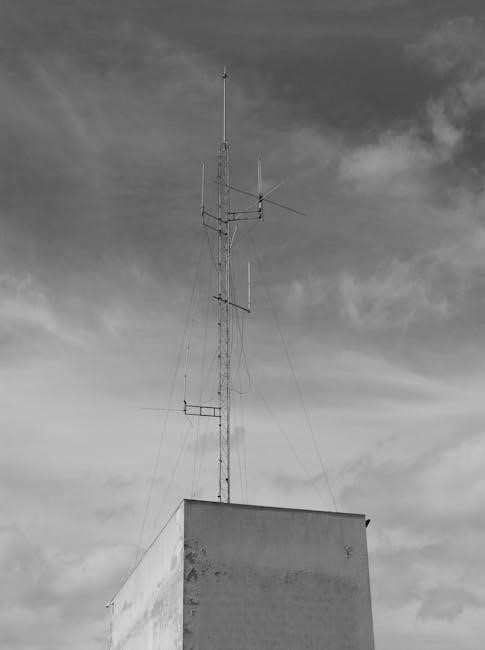Viper Remote Start systems offer convenience and comfort, especially for manual transmission vehicles. They allow users to start their car remotely, ensuring a warm and comfortable ride. Popular for their reliability and advanced features, these systems require careful installation to ensure safety and functionality. This guide provides detailed insights into installing and using Viper Remote Start systems for manual transmissions, focusing on key considerations and best practices.
Overview of Viper Remote Start Systems
Viper Remote Start systems are advanced solutions designed to enhance vehicle convenience and security. These systems allow users to start their car remotely, ensuring a warm or cool interior. They come with features like keyless entry, panic alarms, and trunk release. Viper systems are known for their reliability, ease of use, and compatibility with both automatic and manual transmissions. They include safety features like startup diagnostics and LED confirmation for successful starts. With a wide range of models, Viper offers tailored solutions for different vehicle needs, making them a popular choice for drivers seeking modern automotive upgrades.
Installation Requirements and Preparation
Begin by disconnecting the vehicle’s battery to ensure safety. Identify the neutral safety switch, clutch pedal switch, and ignition wires. Locate a suitable spot for the remote starter module.

Pre-Installation Steps for Manual Transmissions
Before installing a Viper remote start system on a manual transmission vehicle, ensure the car is parked in neutral gear with the parking brake engaged. Disconnect the battery to prevent electrical hazards. Familiarize yourself with the vehicle’s wiring diagram, focusing on the ignition, starter, and clutch pedal switch circuits. Consult the Viper installation manual for specific instructions and compatibility checks. Identify the neutral safety switch and clutch pedal switch locations, as they are crucial for remote start functionality. Plan the module placement for easy access and reliable operation. Proper preparation ensures a smooth and safe installation process.
Identifying Key Vehicle Components (Neutral Safety Switch, Clutch Pedal Switch)
The neutral safety switch and clutch pedal switch are critical components for installing a Viper remote start system in a manual transmission vehicle. The neutral safety switch ensures the vehicle starts only in neutral gear, preventing accidental starting in gear. The clutch pedal switch monitors the clutch pedal’s position, verifying it is fully pressed before remote starting. Locate these switches by consulting the vehicle’s wiring diagram or repair manual; Proper identification is essential for safe and correct installation, as incorrect wiring can lead to system malfunctions or safety risks. Always refer to the Viper installation guide for specific instructions.
Wiring and Connections
Understanding the wiring diagram is essential for a seamless Viper remote start installation. Connect the clutch pedal switch, ignition wires, and neutral safety switch accurately. Use a bypass module if required to ensure compatibility. Proper wiring ensures safe and reliable operation. Always refer to the vehicle’s wiring harness and Viper instructions for precise connections. Incorrect wiring can lead to system malfunctions or electrical damage. Ensure all connections are secure and insulated to prevent short circuits.
Understanding the Wiring Diagram for Manual Transmissions
Understanding the wiring diagram is critical for a successful Viper remote start installation in manual transmission vehicles. The diagram outlines connections for the neutral safety switch, clutch pedal switch, and ignition wires. For manual transmissions, ensure the bypass module is correctly integrated to simulate automatic transmission signals. Use the diagram to identify and connect the starter, ignition, and accessory wires. Properly interpret color-coded wires and symbols to avoid errors. Always test connections before starting the vehicle to ensure functionality and safety. Refer to the Viper manual and vehicle-specific wiring harness for precise instructions.
Connecting the Remote Starter Module
Connecting the remote starter module involves securing it in a suitable location and wiring it to key vehicle components. Identify and connect the ignition, starter, and accessory wires using the wiring diagram. Ensure the neutral safety switch and clutch pedal switch are properly integrated for manual transmissions. Use a multimeter to verify wire functionality before connections; Secure all wires neatly and test the remote start function to confirm proper operation. Consult the Viper manual for specific wiring instructions and troubleshooting tips to ensure a safe and reliable installation.

Safety Considerations and Risks
Improper installation of remote start systems in manual transmissions can pose risks, including electrical damage or unintended vehicle movement. Always follow safety protocols and ensure professional installation.
Potential Risks of Remote Start in Manual Transmissions
Remote starting a manual transmission vehicle poses unique risks, such as unintended movement if the clutch is not properly engaged. Improper installation can lead to electrical system damage or fire hazards. Additionally, incorrect wiring of the neutral safety switch or clutch pedal switch may result in the vehicle starting in gear, causing it to roll or collide. These risks are heightened in manual transmissions due to the absence of an automatic neutral safety feature. Proper installation and adherence to safety guidelines are critical to mitigate these risks and ensure safe operation of the remote start system.
Best Practices for Safe Installation
For a safe and reliable remote start installation in a manual transmission vehicle, always disconnect the battery before starting work. Ensure the neutral safety switch and clutch pedal switch are properly wired to prevent unintended starts. Use a multimeter to verify wiring connections and consult the vehicle’s wiring diagram. Professional installation is highly recommended due to the complexity of manual transmissions. Follow the manufacturer’s instructions carefully and test the system thoroughly after installation. Proper programming of the virtual tachometer is essential for smooth operation. By adhering to these guidelines, you can ensure a safe and functional remote start system for your manual transmission vehicle.

Programming the Remote Start System
Programming involves initial setup and configuration for manual transmissions. Remote start the engine, allowing up to three crank attempts for proper synchronization. Follow the manufacturer’s guide for accurate programming to ensure smooth operation and compatibility with your vehicle’s specific requirements.
Initial Setup and Configuration
Initial setup for Viper remote start in manual transmissions requires precise configuration. Begin by disconnecting the vehicle’s battery to ensure safety. Locate key components like the ignition wire, neutral safety switch, and clutch pedal switch. These connections are crucial for proper functionality. Once the remote starter module is installed, follow the manufacturer’s guide to program the system. This involves syncing the remote and setting up features like timer mode or valet mode. Proper configuration ensures the remote start operates seamlessly with your manual transmission, providing reliable performance and convenience.
Programming the Virtual Tach for Manual Transmissions
Programming the Virtual Tach for a Viper remote start system in a manual transmission involves a learning process where the system adapts to the engine’s RPM pattern. After installation, start the engine to allow the system to capture the RPM variation. This process ensures the remote start operates smoothly by recognizing the engine’s characteristics. The Virtual Tach feature is essential for reliable remote starts, as it tailors the system’s response to the manual transmission’s specifics, ensuring seamless functionality and preventing potential issues.

Troubleshooting Common Issues
Identify issues by checking battery connections, neutral safety switch, and clutch pedal switch functionality. Ensure proper wiring and restart the system after addressing any faults or disconnections.
Diagnosing Startup Failures

Startup failures can occur due to issues like battery disconnection, faulty neutral safety switch, or improper wiring. Check the system’s LED indicators or remote control feedback for error codes. Ensure the clutch pedal switch and ignition wires are correctly connected. Verify the vehicle is in neutral gear, as manual transmissions require this for remote start. If the system fails to crank, consult the Viper installation manual for troubleshooting steps. Resetting the system or reprogramming the virtual tach may resolve the issue. Always follow safety guidelines to avoid damaging the electrical system or causing unintended startups.
Resolving Common Problems with Manual Transmission Remote Start
Common issues with manual transmission remote start systems often stem from improper neutral gear detection or faulty clutch pedal inputs. Ensure the neutral safety switch and clutch pedal switch are properly connected and functioning. If the vehicle fails to start, verify the system’s wiring, especially the ignition and starter circuits. Resetting the remote start module or reprogramming the virtual tach can resolve issues. Consult the Viper manual for specific troubleshooting steps. Always ensure the vehicle is in neutral and the parking brake is engaged before attempting remote start to avoid unintended movement and ensure safe operation.

Maintenance and Upkeep
Regularly check the remote start system’s wiring and battery connections to ensure optimal performance. Update the software periodically to maintain functionality and security, as advised by the Viper manual and online resources. Perform routine inspections of the neutral safety switch and clutch pedal switch to prevent startup issues. Ensure the parking brake and transmission are properly engaged to avoid system malfunctions. Follow the manufacturer’s guidelines for maintenance to prolong the life of your Viper remote start system and ensure reliable operation in manual transmission vehicles. This helps maintain the system’s efficiency and safety features over time.
Regular Checks for Optimal Performance
Perform regular inspections of the Viper remote start system to ensure smooth operation. Check the battery connections and wiring for any signs of wear or damage. Verify that the neutral safety switch and clutch pedal switch are functioning correctly, as improper engagement can prevent the remote start from activating. Test the remote start feature periodically to ensure it works as expected. Inspect the parking brake sensor to confirm it’s properly engaged when using the remote start. Also, ensure the system’s software is up-to-date with the latest firmware. These checks help maintain reliability and prevent potential issues with your manual transmission vehicle’s remote start system. Regular maintenance ensures your Viper remote start continues to provide convenience and comfort without compromising safety or performance.
Battery Care and System Updates
Proper battery care is essential for the Viper remote start system’s performance. Ensure the vehicle’s battery is fully charged and connections are clean to avoid startup issues. Regularly inspect the remote start module’s battery and replace it as needed. Keep the system updated with the latest firmware to enhance functionality and security. Refer to the owner’s guide for update instructions. A well-maintained battery and updated system ensure reliable operation and prevent potential failures. Regular checks and timely updates are crucial for optimal performance and longevity of your Viper remote start system in manual transmission vehicles. This maintains convenience and safety over time.

